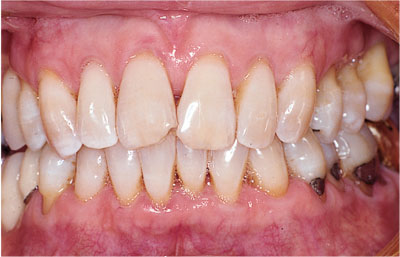Chapter 2
Changing Times: The Dentate Elderly
Aim
The aim of this chapter is to describe current trends in the dental status of the elderly, including factors influencing attitudes to oral healthcare in this age group.
Outcome
At the end of this chapter, the practitioner should be aware that tooth retention in older adults is increasing. In addition, oral health of older adults is variable and presents a range of clinical challenges. It seems likely that edentulousness will be less acceptable to current and future older adults than in the past. The practitioner will have to determine the level of oral function that is acceptable to individual patients and plan care accordingly. It should be recognised that some older adults will still lose their teeth, and in this situation a controlled progression to edentulism should be planned.
Attitudes to Teeth: Influences on Patients
It seems likely that the current generation of older adults has greater expectations of oral health than previous generations. In the past, the vast majority of older adults were edentulous and a significant portion of dentists’ time was spent rehabilitating edentulous older adults. Recent adult dental health surveys indicate that older adults no longer consider total tooth loss as an inevitable consequence of old age, and increasing numbers of older adults are likely to be distressed at the thought of losing all of their natural teeth. They are less likely to accept complete removable dentures, and will be better informed about treatment options. The clinician may be asked to provide complex restorations and should not be inhibited from doing so if it is considered an appropriate treatment option. It is important to remember that old age is not inevitably associated with ill health and that advancing years is not necessarily a contraindication to treatment such as implant-retained restorations. Trends indicate that total tooth loss tends to cluster in socio-economically deprived areas. In more affluent areas, older adults are more likely to seek restorative dental treatment to maintain compatibility with their peers. A further influence on older adults is the opinion of their family. The clinician may find that they have to explain treatment options to immediate family members, as they have an influence on the patient’s ability to attend for treatment and may also be the financial provider for the patient.
The clinician should also be conscious of the apparent divergence of opinion between demands of older adults and professionally assessed treatment need. This phenomenon has been described in many parts of the medical and dental literature, and suggests that acceptance of advice and treatment from health care professionals is not unquestioned.
Dentate Older Adults: Are They All the Same?
The range of treatment options available for older adults depending on dental status is shown in Fig 2-1.

Fig 2-1 Possible treatment options for the older adult depending on dental status.
The elderly dentate population can present in a variety of dental states. These can be characterised as follows.
The dentally-aware, low-maintenance patient
The dentally aware, low-maintenance patient will have been fairly resistant to dental disease. They may have lost some periodontal support, but generally have very little periodontal pocketing. A number of teeth may have been heavily restored or have full coverage crown restorations. Very few, if any, teeth have been extracted and those that have been lost may be replaced by fixed bridgework. These patients are usually very dentally aware, and practise satisfactory plaque-control measures. Such a patient is seen in Fig 2-2. This is a 74-year-old lady who has attended regularly for dental inspection visits. Her periodontal state is excellent, and her oral hygiene impeccable. She has had some conventional and resin-bonded bridgework to replace missing teeth in her lower jaw. She requested replacement of these missing teeth as she felt her chewing ability and appearance were affected by losing teeth. Otherwise, her dental health was excellent. Such a patient requires routine inspections once or twice a year, and should have very few problems with her teeth.

Fig 2-2 Healthy dentition of a 74-year-old, dentally aware female patient. Low maintenance is required.
The dentally-aware, high-maintenance patient
Other patients may be dentally aware, but have been more susceptible to dental disease and thus require more maintenance. They may have already lost a significant number of teeth, and had these replaced with removable partial dentures (RPDs) or extensive fixed bridgework retained on teeth or implants. There may have been significant loss of periodontal attachment and some teeth may show signs of mobility. The history given by the patient may indicate that tooth loss has been gradual or possibly that they have had a stable dentition for a long period of time. The patient shown in Fig 2-3 is an example of such a case. This 65-year-old lady has extensive porcelain-fused-to-metal crownwork on her maxilla/>
Stay updated, free dental videos. Join our Telegram channel

VIDEdental - Online dental courses


